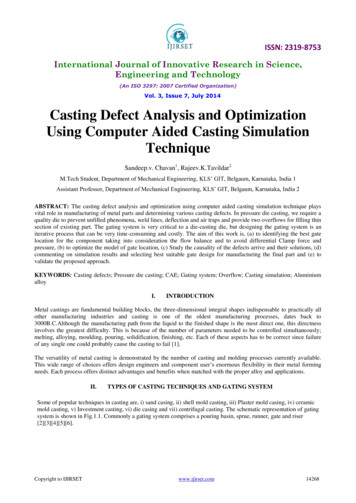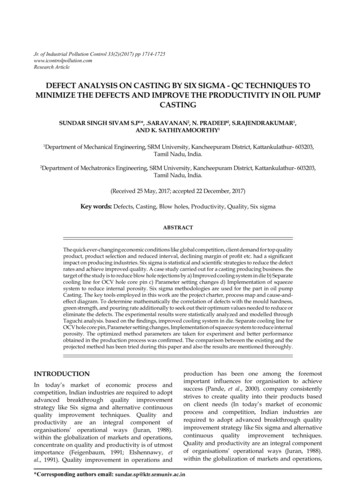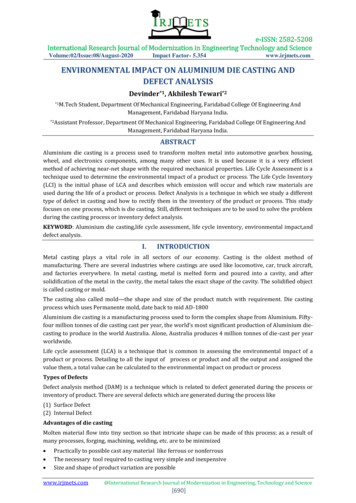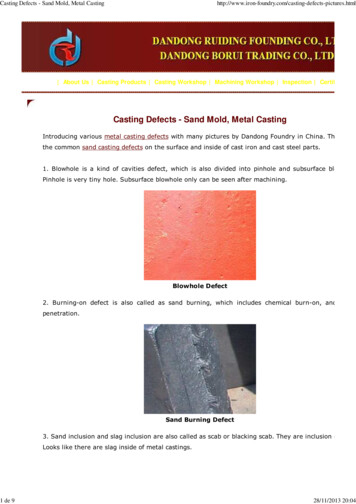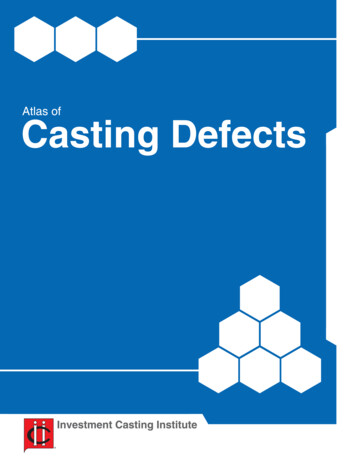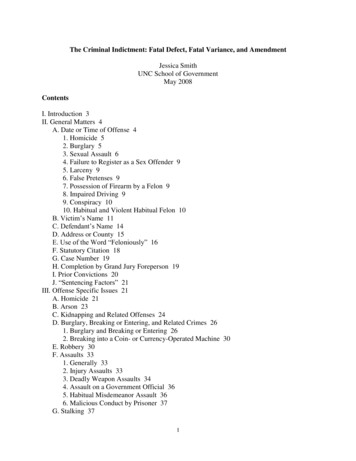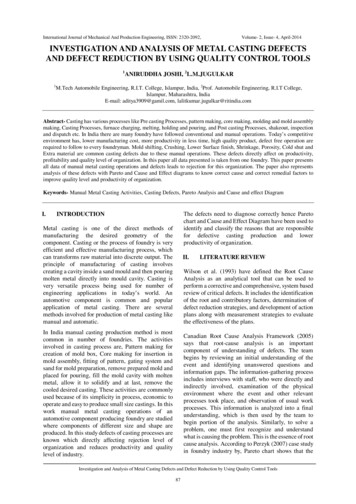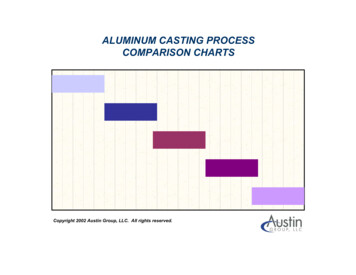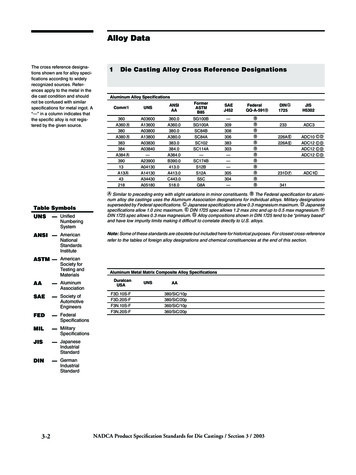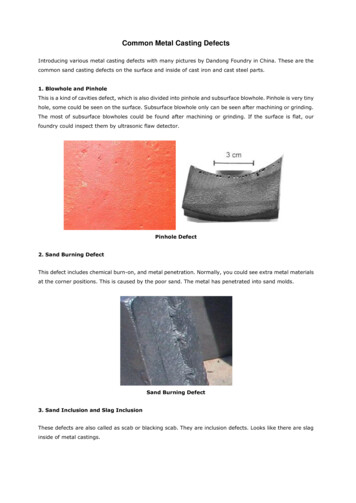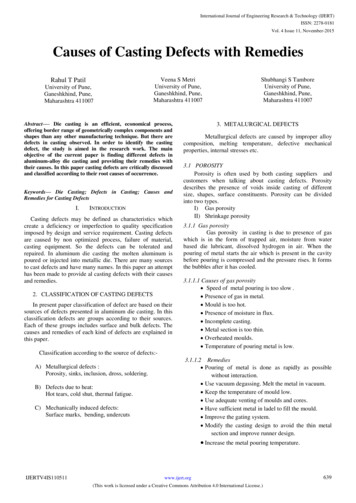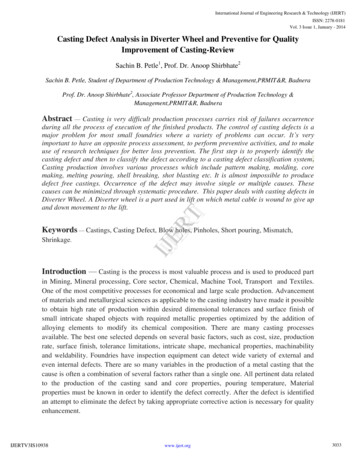
Transcription
International Journal of Engineering Research & Technology (IJERT)ISSN: 2278-0181Vol. 3 Issue 1, January - 2014Casting Defect Analysis in Diverter Wheel and Preventive for QualityImprovement of Casting-ReviewSachin B. Petle1, Prof. Dr. Anoop Shirbhate2Sachin B. Petle, Student of Department of Production Technology & Management,PRMIT&R, BadneraProf. Dr. Anoop Shirbhate2, Associate Professor Department of Production Technology &Management,PRMIT&R, BadneraAbstract — Casting is very difficult production processes carries risk of failures occurrenceIJERTduring all the process of execution of the finished products. The control of casting defects is amajor problem for most small foundries where a variety of problems can occur. It’s veryimportant to have an opposite process assessment, to perform preventive activities, and to makeuse of research techniques for better loss prevention. The first step is to properly identify thecasting defect and then to classify the defect according to a casting defect classification system.Casting production involves various processes which include pattern making, molding, coremaking, melting pouring, shell breaking, shot blasting etc. It is almost impossible to producedefect free castings. Occurrence of the defect may involve single or multiple causes. Thesecauses can be minimized through systematic procedure. This paper deals with casting defects inDiverter Wheel. A Diverter wheel is a part used in lift on which metal cable is wound to give upand down movement to the lift.Keywords — Castings, Casting Defect, Blow holes, Pinholes, Short pouring, Mismatch,Shrinkage.Introduction — Casting is the process is most valuable process and is used to produced partin Mining, Mineral processing, Core sector, Chemical, Machine Tool, Transport and Textiles.One of the most competitive processes for economical and large scale production. Advancementof materials and metallurgical sciences as applicable to the casting industry have made it possibleto obtain high rate of production within desired dimensional tolerances and surface finish ofsmall intricate shaped objects with required metallic properties optimized by the addition ofalloying elements to modify its chemical composition. There are many casting processesavailable. The best one selected depends on several basic factors, such as cost, size, productionrate, surface finish, tolerance limitations, intricate shape, mechanical properties, machinabilityand weldability. Foundries have inspection equipment can detect wide variety of external andeven internal defects. There are so many variables in the production of a metal casting that thecause is often a combination of several factors rather than a single one. All pertinent data relatedto the production of the casting sand and core properties, pouring temperature, Materialproperties must be known in order to identify the defect correctly. After the defect is identifiedan attempt to eliminate the defect by taking appropriate corrective action is necessary for qualityenhancement.IJERTV3IS10938www.ijert.org3033
International Journal of Engineering Research & Technology (IJERT)ISSN: 2278-0181Vol. 3 Issue 1, January - 2014Flow Process Chart For Diverter Wheel CastingStartNONOMelting RawMaterial InspectionNOMolding Sand RawMaterial InspectionOKMold InspectionOKFurnace chargeinspectionOKMolding sandpreparationOKPattern InspectionOKCore MakingOKOKQ.C. In – lineInspectionMelting InspectionNOOKIn – line InspectionNOAdjustmentIJERTMolding operationOKOKQ.C. In – lineInspectionPouringPouring timeOKShake OutKnock OutShot BlastNOQ. C. CheckOKMachiningFinal InspectionNOScarpStorage & DeliveryIJERTV3IS10938www.ijert.org3034
International Journal of Engineering Research & Technology (IJERT)ISSN: 2278-0181Vol. 3 Issue 1, January - 2014Various Defect In Diverter Wheel CastingAny unwanted deviation from the desired requirements in a cast product results in a defect.Some defects in the cast products are tolerable while others can be rectified by additionalprocesses like welding etc. The following are the major defects which are likely to occur insand castings:A. Gas defectsB. Shrinkage cavitiesC. Molding material defectsD. Pouring metal defectsE. Metallurgical defectsA. Gas Defect1. Blow holes and Open blows: These are spherical, flattened or elongated cavitiesIJERTpresent inside the casting or on the surface. When present inside the casting it iscalled blow hole while it is termed as open blow if it appears on the surface of thecasting. These defects are caused by the moisture left in the mould and the core. Dueto heat of the molten metal the moisture is converted into steam, part of which whenentrapped in the casting ends up as blow hole or ends up as open blow when itreaches the surface. Thus in green sand mould it is very difficult to get rid of theblow holes, unless properly vented.Fig. 1.1Causes:1. Excessive moisture in the molding sand.2. Low permeability and excessive fine grain sands.3. Cores neither properly baked not adequately vented.4. Extra hard rammed sand.5. Rusted and dam chills, chaplets and inserts.6. Excessive use of organic binders.Remedies Measure:1.Control moisture content.2. Use clean and rust free Chills, chaplets and metal insert.3. Bake cores property.4. Proper use of organic binders.5. Cores and moulds should be property vented.6. Moulds should not be rammed excessively hard.IJERTV3IS10938www.ijert.org3035
International Journal of Engineering Research & Technology (IJERT)ISSN: 2278-0181Vol. 3 Issue 1, January - 20142. Pin hole porosity: As the molten metal gets solidified it loses the temperaturewhich decreases the solubility of gases and thereby expelling the dissolved gases.The hydrogen which is picked up by the molten metal either in the furnace from theunburnt fuel or by the dissociation of water inside the mould cavity may escape thesolidifying metal leaving behind very small diameter and long pin holes showing thepath of escape. The high pouring temperature which increases the gas pick up is themain reason for this defect.Fig. 1.2Causes:IJERT1. High pouring temperature.2. Gas dissolved in metal charge.3. Less flux used.4. Molten metal not properly degassed.5. Slow solidification of casting.6. High moisture and low permeability in mold.Remedial Measures:1. Vacuum melting2. Vacuum degassing3. Avoiding very high pouring temperature.B. Shrinkage Cavity3. Shrinkage Cavity: Shrinkage faults are faults caused by improper directionalsolidifications, poor gating and rising design and inadequate feeding. Solidificationleads to volumetric contraction which must be compensated by feeding. If thiscompensation is inadequate either surface shrinkage or internal shrinkage defects areproduced making the casting weaker.IJERTV3IS10938www.ijert.org3036
International Journal of Engineering Research & Technology (IJERT)ISSN: 2278-0181Vol. 3 Issue 1, January - 2014Fig. 1.3Causes:1. Faulty gating and risering system.2. Improper chilling.Remedial Measures:IJERT1. Ensure proper directional solidification by modifying gating, riseringand chilling.D. Molding Material Defects4. Mismatch: A misalignment between two halves of a mould or of a core may giverise to a defective casting.Fig. 1.4Causes:1. Misalignment2. Worn out clamping pins.3. Improper support and incorrect location.4. Faulty core boxes.Remedies:1. Repair and replace the pins.2. Provide adequate support to core.5. Scabbing: This refers to the rough thin layer of a metal, protruding above thecasting surface, on top of a thin layer of sand. The layer is held onto the casting by ametal stringer through the sand. A scab results when the upheaved sand isIJERTV3IS10938www.ijert.org3037
International Journal of Engineering Research & Technology (IJERT)ISSN: 2278-0181Vol. 3 Issue 1, January - 2014separated from the mould surface and the liquid metal flows into the spacebetween the mould and the displaced sand.Fig. 1.5Causes:1. Continuous large flat surfaces on casting.2. Excessive mold hardness.3. Lack of combustible additives in molding sand.Remedies:1. Break continuity of large flat groves and depressions2. Reduce mold hardness.3. Add combustible additives to sand.6. Sand Drop: An irregularly shaped projection on the cope surface of a casting isIJERTcalled a drop. This is caused by dropping of sand from the cope or other overhangingprojections into the mould. An adequate strength of the sand and the use of gaggerscan help in avoiding the drops.Fig. 1.6Causes:1. Low green strength in molding sand and core.2. Too soft ramming.3. Inadequate reinforcement of sand and core projectionsRemedies:1. Increase green strength of sand mold.2. Provide harder ramming.3. Provide adequate reinforcement to sand projections and cope by usingnails and gaggers.E. Pouring Metal Defects7. Sand inclusions: Sand inclusion is one of the most frequent causes of castingIJERTV3IS10938www.ijert.org3038
International Journal of Engineering Research & Technology (IJERT)ISSN: 2278-0181Vol. 3 Issue 1, January - 2014rejection It is often difficult to diagnose, as these defects generally occur at widelyvarying positions andare therefore very difficult to attribute to a local cause.Areas of sand are often torn away by the metal stream and then float to the surface ofthe casting because they cannot be wetted by the molten metal. Sand inclusionsfrequently appear in association with CO blowholes and slag particles. Sandinclusions can also be trapped under the casting surface in combination with metaloxides and slags, and only become visible during machining. If a loose section ofsand is washed away from one part of the mould, metallic protuberances will occurhere and have to be removed.Causes :1. Faulty gating.2. Faulty pouring.3. Inferior molding or core sand.4. Soft ramming of mold.5. Rough handling of mold and core.Remedies:IJERT1. Modify gating system2. Improve pouring to minimize turbulence.3. Use of superior sand of good strength.4. Provide hard, ramming.8. Slag inclusions: During the melting process, flux is added to remove theundesirable oxides and impurities (refractory materials, sand) present in the metal.At the time of tapping, the slag should be properly removed from the ladle, beforethe metal is poured into the mould. Otherwise any slag entering the mould cavitywill be weakening the casting and also spoiling the surface of the casting.Fig. 1.7Causes :1. Faulty gating.2. Faulty pouring.3. Inferior molding or core sand.4. Soft ramming of mold.5. Rough handling of mold and core.Remedies:1. Modify gating system2. Improve pouring to minimize turbulence.3. Use of superior sand of good strength.4. Provide hard, ramming.IJERTV3IS10938www.ijert.org3039
International Journal of Engineering Research & Technology (IJERT)ISSN: 2278-0181Vol. 3 Issue 1, January - 20149. Cold shut: For a casting with gates at its two sides, the misrun may show up atthe centre of the casting due to non fusion of two streams of metal resulting in adiscontinuity or weak spot in casting. Above two defects are due to lower fluidity ofthe molten metal or small thickness of the casting. The fluidity of the metal can beincreased by changing the composition of molten metal or raising the pouringtemperature. The other causes for these defects are large surface area to volumeratio of the casting, high heat transfer rate of the mould material and back pressureof the gases entrapped in the mould cavity due to inadequate venting.Figure 1.s8Causes:Remedies:IJERT1. Lack of fluidity in molten metal.2. Faulty design.3. Faulty gating.1. Adjust proper pouring temperature.2. Modify design.3. Modify gating system10.Poured short: The upper portion of the casting is missing. The edges adjacent tothe missing section are slightly rounded; all other contours conform to the pattern.The spree, risers and lateral vents are filled only to the same height above the partingline, as is the casting (contrary to what is observed in the case of defect).Causes:1. Insufficient quantity of liquid metal in the ladle;2. Premature interruption of pouring due to workman’s error.Remedies:1. Have sufficient metal in the ladle to fill the mold;2. Check the gating system;3. Instruct pouring crew and supervise pouring practice.IJERTV3IS10938www.ijert.org3040
International Journal of Engineering Research & Technology (IJERT)ISSN: 2278-0181Vol. 3 Issue 1, January - 2014R EVIEW OF WORK CARRIED OUTSi-Young Kwak1, Jie Cheng, [1] Shrinkage cavity may be detrimental to mechanical performances ofcasting parts. In this paper, process of Al alloy wheel impact test was computationally analyzed for boththe wheel models with and without shrinkage cavity defects. After the impact simulation was conducted,the results show that under impact test condition, the wheel considering shrinkage cavity defects mayfracture while the sound-assumed wheel may not. For impact test analysis of casting Al wheel, theproposed analysis results show that the shrinkage cavity located in high strained area of casting part maybe far more detrimental than in low strained area. In conclusion, the proposed approach can reflect strainconcentration effect and improve the accuracy of simulation with proper computational cost.IJERTL.A. Dobrzanski, M. Krupinski [4] this publication is to present the methodology of the automaticsupervision and control of the technological process of manufacturing the elements from aluminum alloysand of the methodology of the automatic quality assessment of these elements basing on analysis ofimages obtained with the X-ray defect detection, employing the artificial intelligence tools. Themethodologies developed will make identification and classification of defects possible and theappropriate process control will make it possible to reduce them and to eliminate them - at least in part.The developed computer system, in which the neural networks as well as the method of automatic imageanalysis were used, can ensure the automatic identification and classification of
casting defect and then to classify the defect according to a casting defect classification system. Casting production involves various processes which include pattern making, molding, core making, melting pouring, shell breaking, shot blasting etc. It is almost impossible to produce defect free castings. Occurrence of the defect may involve single or multiple causes. These causes can be .
